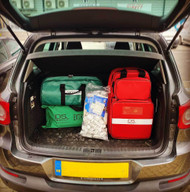Preparing Your Team for Autumn/Winter Medical Emergencies: Essential Equipment Checklist
Posted by DS Medical on 3rd Sep 2025
As the days grow shorter and temperatures drop, workplaces across the UK face a surge in seasonal risks. From slips and falls on icy surfaces to respiratory illnesses, autumn and winter bring unique challenges that can stretch resources and delay emergency responses.
Whether you’re part of a confined space rescue team, facilities management department, renewable energy site, aesthetic clinic, or private ambulance service, ensuring your team is equipped with the right medical supplies is crucial. Being prepared can make the difference between a quick, effective response and a preventable escalation.
In this guide, we’ll cover the key risks and outline an essential medical equipment checklist to keep your team ready for the colder months.
Why Autumn/Winter Increases Medical Risks
Colder weather impacts both patients and responders. Some of the most common seasonal risks include:
- Weather-related injuries – Slips, trips, and falls on ice or wet surfaces often result in sprains, fractures, or head injuries.
- Hypothermia and cold stress – Outdoor workers and vulnerable patients are at higher risk of hypothermia and shock.
- Respiratory emergencies – Flu season, asthma, and COPD flare-ups increase demand for oxygen therapy and airway management.
- Slower emergency response times – Snow, ice, and flooding can delay ambulance arrivals, placing greater importance on on-site preparedness.
With these risks in mind, it’s vital that teams have access to reliable, well-stocked medical equipment.
The Essential Equipment Checklist
Here are the must-have items to review and restock before winter sets in:
- Thermal & Hypothermia Management
Preventing heat loss is critical in emergencies. Even mild hypothermia can complicate treatment and recovery.
- Thermal Emergency Blankets such as Thermarmour Emergency Blankets or Blizzard blankets – Provide superior insulation in prolonged exposure or trauma situations.
- Trauma & First Aid Kits
Falls and slips spike in winter, often resulting in trauma injuries. Ensure kits are complete and easy to access.
- Trauma dressings and bandages, such as Ambulance Dressing, High Pressure Dressing or Olaes Bandage to name a few.
- Splints for fractures and sprains for example, SAM Splints, Vacuum Splints or Traction Splints.
- Medical kits for instance FREC3 or FREC 4
- Diagnostic Tools
Quick assessment saves lives, particularly in respiratory or circulatory emergencies.
- Thermometers – Non-Contact, Flexitip or Tympanic thermometers
- Pulse oximeters – Monitor oxygen saturation in flu, asthma, or COPD patients.
- Blood pressure monitors – Essential for accurate triage.
- Glucose Meters – Crucial for monitor glucose levels
- Airway & Oxygen Management
Respiratory issues are more common in colder months. Having oxygen and airway tools on-site ensures early intervention.
- Oxygen masks
- Nebuliser Masks
- Bag-valve masks
- Suction units for airway clearance
- Defibrillators (AEDs) & Readiness
Cold stress and seasonal exertion can increase the risk of sudden cardiac arrest. AEDs should be visible, accessible, and regularly checked.
- Public access AEDs for facilities and workplaces
- Portable AEDs for ambulances, rescue, and remote sites
- AED trainer units for seasonal refresher training
- Confined Space & Outdoor Work Essentials
For rescue teams, facilities staff, and renewable energy workers, winter adds further hazards.
- Head torches and gloves for safe handling in poor light
- Portable stretchers for rapid evacuation such as Saviour Technical
Training & Staff Preparedness
Equipment alone isn’t enough — your team must feel confident using it. Autumn and winter are the perfect time to schedule refresher training in:
- Basic Life Support (BLS) and CPR
- AED use
- Oxygen therapy and airway management
- Hypothermia and shock treatment
Training products such as AED trainers, CPR manikins, and consumables allow realistic practice and help maintain staff confidence.
DS Medical Recommendations
At DS Medical, we supply a wide range of emergency medical equipment, consumables, and training products designed to keep your team prepared. From compact first aid kits to fully equipped trauma bags and defibrillators, we support professionals across healthcare, rescue, and workplace environments.
Don’t wait until the first frost. Check your equipment now, restock essential supplies, and ensure your team is trained and ready for the season ahead.
Call to Action
Prepare today for tomorrow’s emergencies.
Explore our full range at dsmedical.co.uk
For more seasonal safety tips and product updates, sign up to our DS Medical newsletter.


